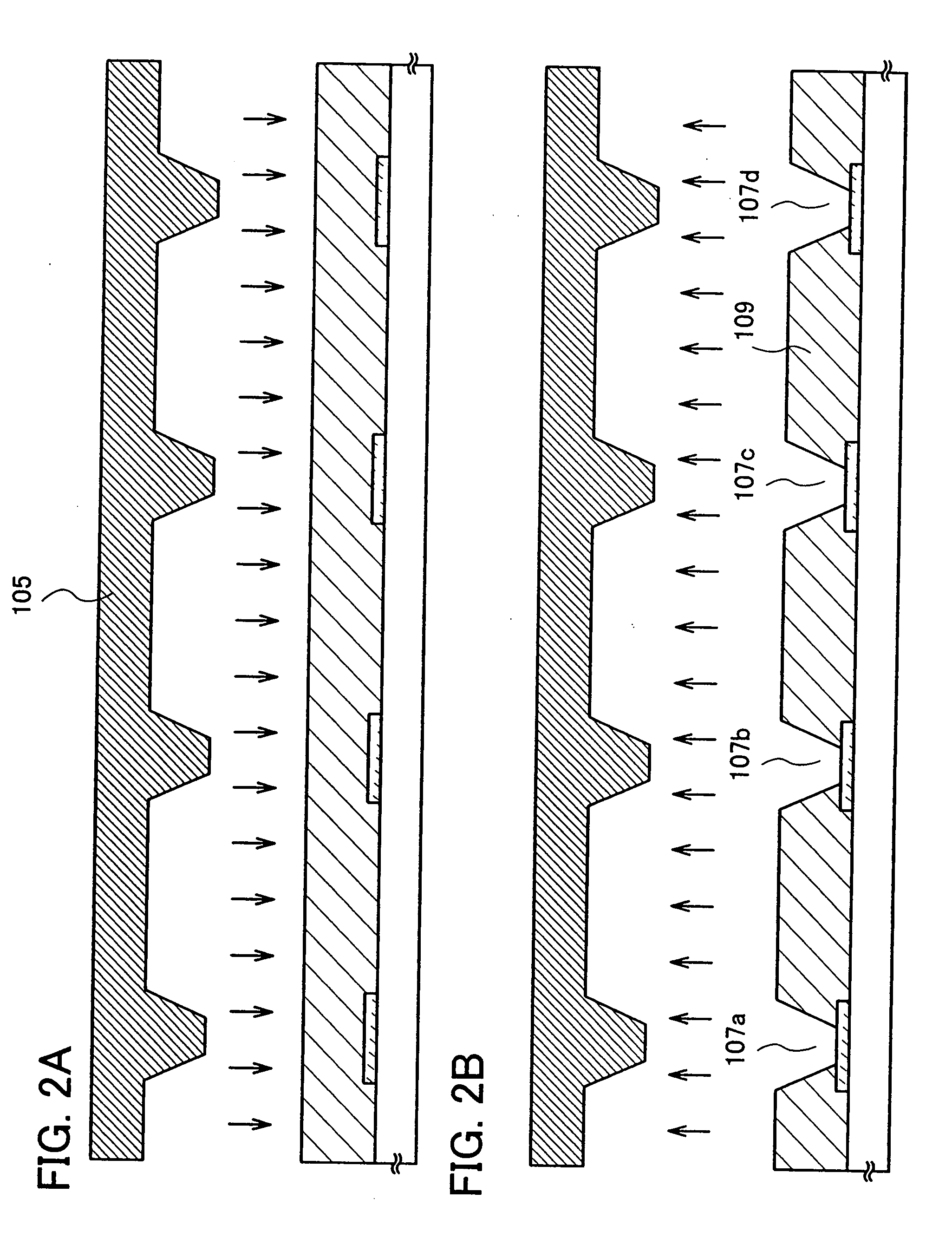Method for manufacturing semiconductor device
a manufacturing method and semiconductor technology, applied in the direction of semiconductor devices, basic electric elements, electrical equipment, etc., can solve the problems of damage to wiring, defect in etching using fluorine solution, etc., and achieve the effect of simple method, excellent reproducibility, and high durability
- Summary
- Abstract
- Description
- Claims
- Application Information
AI Technical Summary
Benefits of technology
Problems solved by technology
Method used
Image
Examples
embodiment 1
[0074]An example of using a method for manufacturing a semiconductor device of the present invention will be explained with reference to FIGS. 4A to 4D, FIGS. 5A to 5C, FIGS. 6A to 6C, FIGS. 7A and 7B, FIGS. 8A and 8B, FIGS. 9A and 9B, FIG. 10, FIG. 11, and FIG. 12.
[0075]First, as shown in FIG. 4A, a base film 502 is formed over a substrate 501. As the substrate 501, for example, a glass substrate such as barium borosilicate glass or alumino borosilicate glass, a quartz substrate, a stainless steel substrate, or the like can be used. In addition, a substrate made of plastic typified by PET (polyethylene terephthalate), PES (polyethersulfone), or PEN (polyethylene naphthalate), or a substrate made of a flexible synthetic resin such as acrylic can be used.
[0076]The base film 502 is provided in order to prevent an alkali metal such as Na or an alkaline earth metal contained in the substrate 501 from diffusing into a semiconductor film and having an adverse effect on characteristics of ...
embodiment 2
[0174]In this embodiment, an example in which the present invention is applied to an inorganic EL element will be explained with reference to FIGS. 13A to 13C and FIGS. 14A to 14C.
[0175]A light-emitting element utilizing electroluminescence is classified by whether a light-emitting material is an organic compound or an inorganic compound. In general, the former is referred to as an organic EL element and the latter is referred to as an inorganic EL element. The example in which an organic EL element is used in the present invention is described in Embodiment 1.
[0176]The inorganic EL element is classified into a dispersion type inorganic EL element and a thin film type inorganic EL element, depending on its element structure. The former and the latter are different in that the former has an electroluminescent layer in which particles of a light-emitting material are dispersed in a binder, whereas the latter has a light-emitting layer formed of a thin film of a light-emitting material...
embodiment 3
[0211]As electronic appliances to which the present invention is applied, the following can be given: a camera such as a video camera or a digital camera; a goggle type display, a navigation system; an audio reproducing device (such as a car audio component set); a computer; a game machine; a portable information terminal (such as a mobile computer, a cellular phone, a portable game machine, or an e-book reader); an image reproducing device provided with a storage medium (specifically, a device for reproducing a storage medium such as a digital versatile disc (DVD) and having a display for displaying the reproduced image), and the like.
[0212]Specific examples of the electronic appliances are shown in FIG. 15, FIG. 16, FIGS. 17A and 17B, FIG. 18, FIG. 19, FIG. 20, and FIGS. 21A to 21E.
[0213]FIG. 15 shows an EL module in which a display panel 301 and a circuit substrate 311 are combined. In the circuit substrate 311, a control circuit 312, a signal division circuit 313, and the like a...
PUM
| Property | Measurement | Unit |
|---|---|---|
| thickness | aaaaa | aaaaa |
| thickness | aaaaa | aaaaa |
| temperature | aaaaa | aaaaa |
Abstract
Description
Claims
Application Information
 Login to View More
Login to View More - R&D
- Intellectual Property
- Life Sciences
- Materials
- Tech Scout
- Unparalleled Data Quality
- Higher Quality Content
- 60% Fewer Hallucinations
Browse by: Latest US Patents, China's latest patents, Technical Efficacy Thesaurus, Application Domain, Technology Topic, Popular Technical Reports.
© 2025 PatSnap. All rights reserved.Legal|Privacy policy|Modern Slavery Act Transparency Statement|Sitemap|About US| Contact US: help@patsnap.com



